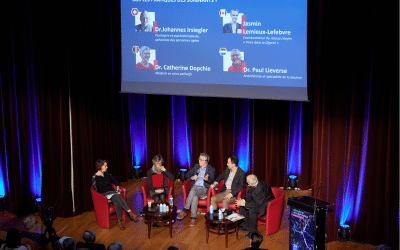Three-dimensional bio-printing appears to be a genuine revolution, and some even consider it as the next industrial revolution. Two major innovations in this field were published this month in the media. What is it about? What is at issue? What can it contribute?
The first innovation concerns 3D laser printing with human tissue (or bio-printing). In early February, 2016, Poietis, a start-up from Bordeaux, announced that it had developed human tissue using 3D laser printing “It consists of combining 3D printing technologic and cell biology to create biological tissue, layer by layer”, summarized Fabien Guillemot, ex-scientist at the National Health Institute and Medical Research (INSERM) and founder of this start-up company in 2014. This procedure of laser bio-printing allows living tissues to be printed in two stages: first the printing, then the maturation of the cells and of the matrix which surrounds them. This process of skin creation lasts approximately three weeks. “The laser has several advantages. For example by very high definition, it can reproduce the entirety of tissues with particularly high accuracy. It also ensures 95 – 100 % viability for the cells.”
This technique appears very promising for skin grafts, especially in treating serious burns, but equally for cosmetic research, especially since the European Union has outlawed test on animals since 2013. Poietis has developed its own 3D laser printer which will be functional in the next two years. It may take a decade before the skin grafts can be performed on humans.
The second innovation involves creating transplants by 3D bio-printing techniques: this past February 15, the scientific review “Nature Biotechnology” revealed the development of a 3D bio-printer capable of recreating muscle, cartilage and even bones from human stem cells by a team of American researchers at the Wake Forest Institute. “This new printer of tissues and organs represents a genuine advance in our tissue replacement research for patients” declared Professor Anthony Atala, the director of the Institute. “We can make human-size stable tissues of any form. In continuing this development, this technology could be used in the future for printing living tissues and organs for surgical implants.”
This type of transplant is not new, but until now the implants were not well adapted to the receiving organism, principally due to problems in reestablishing vascularisation. The recent trials on mice have been conclusive. In the years to come, this technology could compensate for the growing shortage of organ donations. The production times (a few days to a few weeks according to the type of implant) are much shorter than the usual waiting time for an organ donation.
Many promising prospects are in view thanks to these new 3D printing technologies, but nevertheless they raise ethical questions. Fabien Guillemot responded by saying « We have a self-imposed limit of stopping at repairing tissues and not increasing or improving them”.



